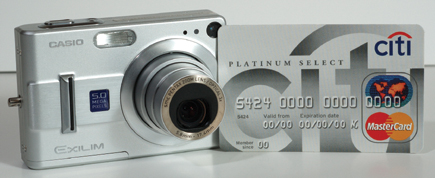Pocket Cameras, Pocket Portfolios; Shoot & Show On The Go
If you are serious about photography, there are two things that you will always
want to do. One is to be able to shoot whenever a picture opportunity presents
itself, and the second is to show your best images to others. Surprisingly,
the best way to accomplish both of those goals may be one of the tiny pocket
cameras like the Casio EXILIM EX-Z55 or Sony Cyber-shot DSC-W5. If you have
been thinking of reasons why you really should buy a tiny, take everywhere digital
camera, consider the added advantage of always having a portfolio with hundreds
of your best images right in your pocket.
The Casio EXILIM EX-Z55 is a 5-megapixel camera that is about the size of a
credit card. Its tiny size ensures it can always be with you, letting you shoot
whenever a picture possibility appears. But its large 2.5" LCD also gives
it the potential to display a portfolio of your best work with remarkable quality.
And unlike bulky boxes of prints, tiny memory cards can store thousands of your
best images--and still fit in your shirt pocket.
 |
|
|
There is only one problem with this concept. Your best pictures have probably been edited in an image-editing program. Once you have modified an image in a program like Photoshop or Elements most cameras will no longer recognize it. You can't just drag images from your computer to a memory card and expect them to show up when you turn your camera on. All those beautifully edited images you have created need a bit of tweaking before your digital camera can become your digital portfolio.
 |
|
|
TVwriter Converts Images To Be Recognized By Your Digital Camera
David Taylor's TVwriter program was designed to quickly and easily modify
your edited image files so your camera will be able to read them again. It can
do single files one at a time, or batch process entire folders of JPEGs. Among
its options are three levels of output image quality (compression) and a wide
range of output sizes. You can also choose a naming convention based on your
camera's proprietary format.
By experimenting I determined that 640x480 was the smallest size that would
still fill the LCD of the Casio EXILIM EX-Z55 I was using. I also chose to compress
the images at the highest quality level, which yielded file sizes in the 100-225K
range. This still allowed me to store between 5-7 images per megabyte, or about
750 images on a $25 128MB memory card. I was even inspired to rummage around
and find some old 8MB cards that came with some early digital cameras I bought--they
now have a new life carrying portfolios of about 50 images each.
 |
|
|
- Log in or register to post comments

































